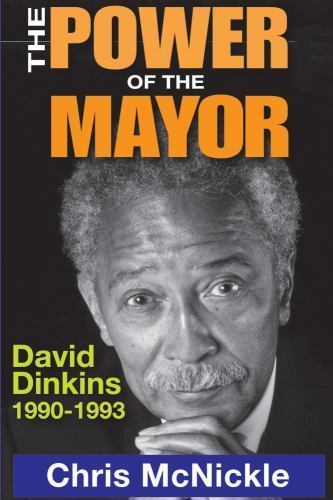Picture 1 of 2

Stock photo


Picture 1 of 2

Stock photo


Power of the Mayor : David Dinkins: 1990-1993 by Chris McNickle and Francisco Alba (2013, Hardcover)

Better World Books (2851369)
99.2% positive feedback
Price:
$58.20
Free shipping
Returns:
30 days returns. Buyer pays for return shipping. If you use an eBay shipping label, it will be deducted from your refund amount.
Condition:
Book
Oops! Looks like we're having trouble connecting to our server.
Refresh your browser window to try again.
About this product
Product Identifiers
PublisherTaylor & Francis Group
ISBN-101412849594
ISBN-139781412849593
eBay Product ID (ePID)117255841
Product Key Features
Number of Pages406 Pages
Publication NamePower of the Mayor : David Dinkins: 1990-1993
LanguageEnglish
Publication Year2013
SubjectAmerican Government / Local, General
TypeTextbook
AuthorChris Mcnickle, Francisco Alba
Subject AreaPolitical Science, Biography & Autobiography
FormatHardcover
Dimensions
Item Height0.9 in
Item Weight24.1 Oz
Item Length9.4 in
Item Width6.7 in
Additional Product Features
Intended AudienceCollege Audience
LCCN2012-014738
TitleLeadingThe
Reviews"Being Mayor of New York has been called the second toughest job in America. David Dinkins, the first black Mayor of New York, was confronted with huge problems involving the faltering economy, public safety, and race relations from his first day in office. Chris McNickle has written knowledgeably of Dinkins and his four years at City Hall. This volume has captured the enormous issues Dinkins faced, his successes and failures and the fact that, throughout his tenure, he managed to maintain an affable, courtly demeanor until the end of his term when he said he hoped to be remembered as 'someone who genuinely cared about people, about all people, especially children.'" --Gabe Pressman, senior correspondent, WNBC, New York "Chris McNickle has drawn in his deep and wide knowledge of the New York mayoralty for his book on David Dinkins' mayoralty. Balanced, fair, and engaging, McNickle's The Power of the Mayor explains why Dinkins' failings were often based on his outdated assumptions about both political ideology and the powers available to city's chief executive under a newly drawn charter. This is an essential book for those interested in both modern New York and modern racial politics." --Fred Siegel, senior fellow at the Manhattan Institute, author of The Prince of the City: Giuliani, New York, and the Genius of American Life "McNickle's account, which moves through Dinkins's term thematically, is at its best when it takes on the intersection of popular perception and governance. His handling of the Crown Heights riots of 1992 is nuanced and evenhanded. . . . McNickle convincingly argues that Dinkins was a poor manager of his public image and an ineffective decision-maker in a city that preferred (or, at least, was used to) a shoot-first approach, using many a bungled initiative or poorly chosen official to drive his point home." --Nick Juravich, Dissent "[The Power of the Mayor is a] critique of David Dinkins' four year term as the mayor of New York, noting the flaws of his political leadership style as well as his political successes which were to include balancing four annual budges, preventing a fiscal takeover by the unelected new York State Financial Control Board, a substantial reduction in the crime rate, structural changes to the municipal public school system, and improved access to health care services for the poor. Informed, informative, insightful, detailed, and superbly written." --Library Bookwatch, Midwest Book Review
Table Of ContentIntroduction; 1: Scandal, Race, and the Seeds of Victory 1; 2: A City in Search of Harmony 1; 3: Credibility Gap, Budget Gap; 4: Policies for a Penniless City; 5: Sexual Dysfunction at the School Board; 6: A City Living in Fear; 7: Policing the Police; 8: Defeat; 9: Measuring Mayor Dinkins's Mettle
SynopsisChris McNickle argues that New York City Mayor David Dinkins failed to wield the power of the mayor with the skill required to run the city, Chris McNickle argues that New York City Mayor David Dinkins failed to wield the power of the mayor with the skill required to run the city. His Tammany clubhouse heritage and liberal political philosophy made him the wrong man for the time. His deliberate style of decision-making left the government he led lacking in direction. His courtly demeanor and formal personal style alienated him from the people he served while the multi-racial coalition he forged as New York's first African-American mayor weakened over time. Dinkins did have a number of successes. He balanced four budgets and avoided a fiscal takeover by the unelected New York State Financial Control Board. Major crime dropped 14 percent and murders fell by more than 12 percent. Dinkins helped initiate important structural changes to the ungovernable school system he inherited. His administration reconfigured health care for the poor and improved access to medical treatment for impoverished New Yorkers. McNickle argues that David Dinkins has received less credit than he is due for his successes because they were overshadowed by his failure to fulfill his promise to guide the city to racial harmony. This stimulating review of a transitional period in New York City's history offers perspective on what it takes to lead and govern.
LC Classification NumberF128.57.D56M36 2012
Be the first to write a review


















